- Bernard Preston homepage
- Solar
- Change Over Switch
Change Over Switch
A change over switch enables you to power certain circuits from mains, solar or a generator.
When you are looking for an alternative source of power for your home or office, such as a solar powered or petrol generator, you must have a device that will isolate the two.
You can't have an appliance being powered by solar and the utility backup simultaneously.
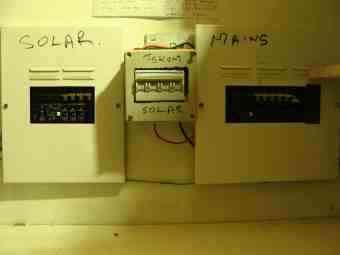
This page was last updated by Bernard Preston on 6th August, 2023.
It can be wired directly into your electrical distribution board but the chances are you have an old DB and your new switch will have different clips; and there won't be room in the box anyway.
So it will need its own housing.
Modern batteries are coming down in price and quite soon going off the grid will become affordable. Then you won't need this device at all, unless you also plan to have a small petrol generator for an extended period of cloudy weather.
The switch will have a neutral position in the centre, where your appliances are isolated from both sources. Then you can toggle with ease from the utility to your solar or petrol generator.
When you are adding a solar powered system to your existing home, you will most likely want to include a new distribution board.
This enables you to continue to power certain heavy current appliances like your hot water geyser and stove from the utility whilst driving the rest of your appliances from the solar generator.
It will depend on the size of your inverter.
The change over switch gives you the option of powering some or all of your appliances from the mains utility, or from the generator; you can with ease toggle back and forth.
Say you have had three cloudy days and your batteries have insufficient energy to continue powering your hot water kettle, vacuum cleaner, and computers; then you can simply flip your change over switch (COS) from your solar generator to your mains utility.
Then when Mr Golden Sun returns, bringing his blessings you can simply flip the transfer switch again, moving the power source back from mains to your solar generator.
Mark I
Batteries do not take kindly to being drained below fifty percent. If you do it regularly you will shorten their life significantly; and they are a costly item in your desire to go green and reduce your carbon footprint.
It makes sense to move back to the mains utility, using your change over switch when the weather is inclement for a protracted period.
Mark one proved unsatisfactory; when it comes to electrical apparatus, purchase the best. Then it hurts only once. Lower down you can see the upgraded COS.
You do also have automatic transfer switches that will change over seamlessly to your mains utility when cloudy weather moves in.
I would recommend them if you are out at work all day but, if there is usually someone at home then the manual change over switch is actually more useful.
You can time the transfer of power better yourself than any automatic unit when you see a bank of cloud approaching; keeping those batteries near to fully charged is important.
If you live in a country with a reliable mains utility, and you have no batteries then an automatic change over switch makes more sense.
But if you have grid power for only parts of the day, as occurs in many third world countries, or regular sudden, unexpected load shedding then you will need storage for your solar energy and a change over switch. In South Africa we are now facing total blackout because of poor maintenance and planning; batteries are vital.
The alternative is you have to go around the house moving the plugs from mains to solar when there's sufficient sun energy, and back again every late afternoon, or if clouds come over.
That's a lot of schlep and a transfer switch makes a lot more sense. They are not particularly expensive, priced at around thirty or forty dollars perhaps; see the update below. I was wrong; a good one is not cheap.
Make sure you purchase a switch that is large enough to carry the expected current. It's better to go a little overboard and have a more powerful device than have yours burn out from too many amps.
My new one will take sixty amps.
In fact I recommend dropping the breaker before changing over so there is no flash; that spark damages the terminals eventually.
Newsletter
Our newsletter is entitled "create a cyan zone" at your home, preserving both yourself and Mother Earth for future generations; and the family too, of course. We promise not to spam you with daily emails promoting various products. You may get an occasional nudge to buy one of my books.
Here are the back issues.
- Lifestyle and ideal body weight
- What are ultra-processed foods?
- Investing in long-term health
- Diseases from plastic exposure
- Intensive lifestyle management for obesity has limited value
- A world largely devoid of Parkinson's Disease
- The impact of friendly bacteria in the tum on the prevention of cancer
- There's a hole in the bucket
- Everyone is talking about weight loss drugs
- Pull the sweet tooth
- If you suffer from heartburn plant a susu
- Refined maize meal and stunting
- Should agriculture and industry get priority for water and electricity?
- Nature is calling
- Mill your own flour
- Bake your own sourdough bread
- Microplastics from our water
- Alternative types of water storage
- Wear your clothes out
- Comfort foods
- Create a bee-friendly environment
- Go to bed slightly hungry
- Keep bees
- Blue zone folk are religious
- Reduce plastic waste
- Family is important
- What can go in compost?
- Grow broad beans for longevity
- Harvest and store sunshine
- Blue zone exercise
- Harvest and store your rainwater
- Create a cyan zone at your home
Here is an important tip; when changing over from one power source to another you will get a small flash as the electricity is disconnected.
It's not unimportant to first drop a few of the circuit breakers to make sure the current passing through the switch is not too high; preferably it would be zero.
I'm fairly sure that is why my first cheap one was damaged.
After changing over to solar, or back to mains remember to flip the circuit breakers up again.
That's not a problem if there is a mains failure, but more usually you will be wanting to transfer power typically every morning to your solar powered generator, and back again every evening to save your batteries from being drained.
Obviously if you have a very large bank of batteries this becomes less important. However, as stated above, good ones are extremely expensive; nurse them.
Here I have a seven years later update to this page. We have upgraded to lithium batteries which have come down in price, and actually the change over switch is hardly used.
If you choose to go off the grid, or it's simply not available at a price you can afford out in the country, then you may have to purchase a very large bank of batteries costing ten thousand dollars and more if you want to have readily available electrical power regardless of the weather.
This is my initial small installation but I have since upgraded all these appliances. My advice is plan to go as big as you can afford from the beginning. Adding more batteries and photovoltaic panels is easy, but having to trade in your inverter and regulator for larger ones is a waste of your time and money.
Try and go for at least a five kilowatt inverter and a sixty amp regulator from the beginning. If you have the money, buy a ten kilowatt inverter and two sixty amp regulators; that's better than one very large regulator, in my opinion. This little 20 amp regulator proved quite insufficient for our needs.
And the two batteries where I started soon needed extra capacity. Adding extras is not difficult. The cables must be short and thick; and you will need to understand the difference between in series and parallel batteries.
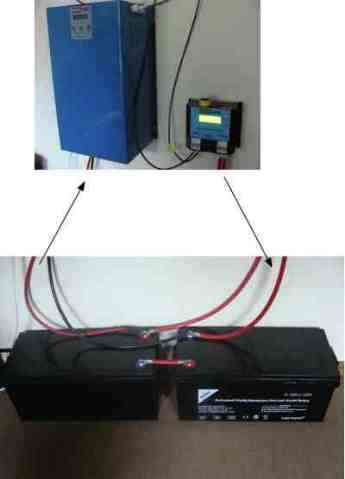
If you plan to go off the grid then you will need obviously a much large bank of batteries to provide power at all times of the day, in all weathers.
These eight batteries cost typically about five hundred dollars apiece, and a battery room enabling you to go off the grid will need to be at least twice that of mine below; it's largely a pipe dream for the average person simply wanting to reduce your carbon footprint.
With the advent of electrical cars there is enormous research being done on batteries and I suspect within a very few short years, everything will change. These will be like Model T Fords!
It's time to shorten those cables to the MPPT.
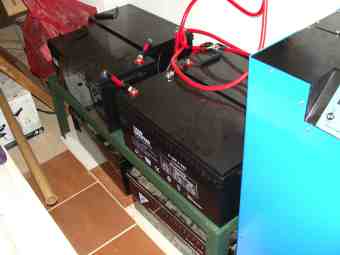
Here are a few links that may be useful to you, if you are taking the first baby steps in the introduction of solar power energy into your home or office.
The choice and installation of your solar generator is, of course, vital.
Go as big as you can afford otherwise you're likely to find yourself doing a solar powered generator upgrade and wasting a lot of time and money; believe me, I have the T-shirt. Now we power our solar electric oven, breadmaker and heavy duty electric lawnmower.
Adding more batteries is relatively simple; they must of course be in parallel, keeping to the overall voltage of your system. This is a 48V system, the highest (always best, with fewer losses) at the moment, with four 12V batteries in series. I have now added a third layer in parallel.
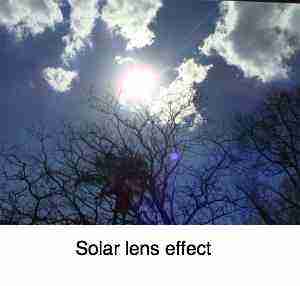
Around the fringes of clouds interestingly you get a solar lens effect which gives huge surges in solar power energy arriving at your PV panels. Make allowance for that when choosing your regulator, also known as a MPPT.
However these surges are usually for a fairly short time, read less than thirty seconds, and a good quality regulator, such as those from MicroCare MPPT has built in protection for short lived surges. My advice? Don't buy less than the 60 amp MPPT; you'll probably be upgrading later otherwise. Do it right first time, and it hurts only once!
Update: I believe that MicroCare now makes a high voltage MPPT, enabling you to put more than four panels in series. A higher voltage means few losses in those cables from the PVs to the MPPT.
Update
Change over switch is also known as a transfer device. Here's an update.
When buying electrical equipment, as in most things, purchase only the best; that switch at the top lasted just over a year.
After much discussion with experts, I spent three times as much on what is apparently the best transfer switch; I'm hoping it lasts for ever. At a little over $100, it wasn't cheap.
A better transfer switch
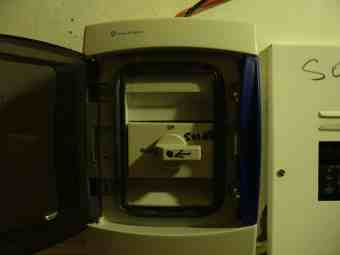
It's also known as a manual transfer switch.
The average person wanting to build a solar generator himself, would probably not be able to cope with the electronics involved in a fully automated system; the manual transfer makes designing and building your own basic system relatively straight forward.
- The solar manual versus automated decision.
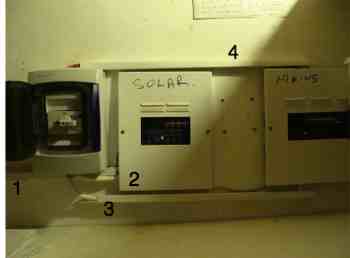
1. Incoming power from the inverter to the solar distribution board.
2. Line passing from the solar DB to the change over switch.
3. Line passing from the mains DB to the change over switch.
4. Line passing from the COS to the mains board to power the oven and plug circuits during the day.
Final connections
This is very important; all the neutral leads that are being powered by the COS must be removed from the mains DB and connected to the neutral that goes to the COS.
Computers
Your computer will not take kindly to being powered via a change over switch; as it passes through the neutral position, your computer will be momentarily without power.
Make sure that your computer has a dedicated solar line. The inverter acts as the perfect uninterrupted power supply, or UPS.
All laptops, and the Apple Mac use very little power, in any case.
Total blackout and load shedding
If you regularly have load shedding, and have a threat of total blackout, then you absolutely must have a battery bank and a COS. A grid tied system without a battery bank will not be able to use energy from the PVs when the grid goes down.
Tip
When toggling from Mains, through the neutral position, to the Solar generator, the COS will break a live circuit; a small flash occurs gradually damaging the terminals. It makes sense to drop the mains breaker first, change over and reset that breaker.
Solar power energy
Solar power energy is free! Only collecting and storing it costs; and transfering those kilowatts via a change over switch to your distribution board.
Most folk use a change over switch to move from mains to a petrol generator. They have their merits and I won't detract, but far rather the use of solar power energy for me. There's no maintenance, zero costs but a lot more in the planning.
One question to be considered before installing photovoltaic cells on your roof is shadows on PV panels. Is there a chimney or tree that could upset the applecart, and how significant are they anyway?
Grid tied residential solar power
Grid tied residential solar power, without batteries, means the inverter will shut down to protect any technicians working on the grid. It's perfect for a country with a stable power supply but for those where there is frequent load shedding or grid failure it's not a good option.
More useful links @ Change Over Switch
When browsing use right click and "Open Link in New Tab" or you may get a bad gateway signal.
Bernard Preston
Bernard Preston is a semi-retired DC; he's also a physics major with an serious interest in matters green. You can learn from his mistakes whilst building a substantial solar farm. For example, when purchasing a change over switch get only the best.
Whilst not an engineer, every day in the life of solar geek Bernard Preston is fascinating.
Did you find this page interesting? How about forwarding it to a friendly book or food junkie? Better still, a social media tick would help.
- Bernard Preston homepage
- Solar
- Change Over Switch
Address:
56 Groenekloof Rd,
Hilton, KZN
South Africa
Website:
https://www.bernard-preston.com